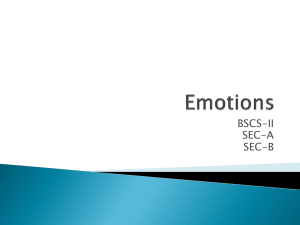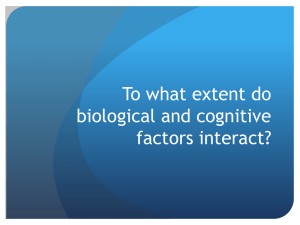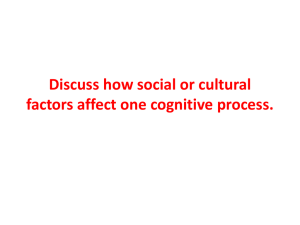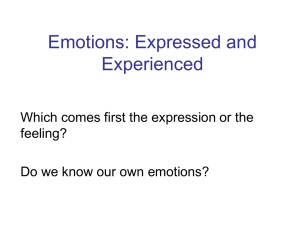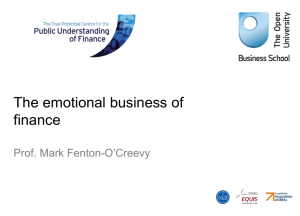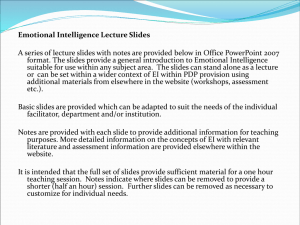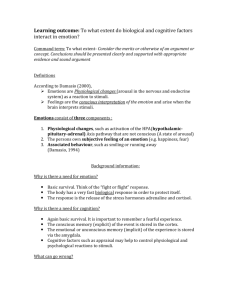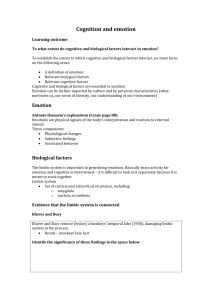Emotions
advertisement
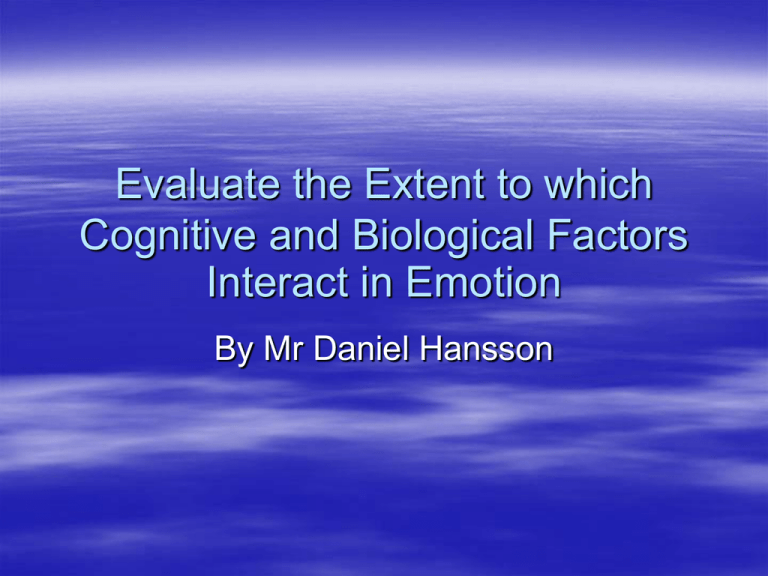
Evaluate the Extent to which Cognitive and Biological Factors Interact in Emotion By Mr Daniel Hansson Evaluate the extent to which cognitive and biological factors interact in emotion Due 18/11 Define emotion Explain the cognitive and biological factors of emotion Explain theories and studies of their interaction 1 theory + 2 studies Evaluate the theories and studies Draw a conclusion Questions for discussion 1. Are thoughts and emotions independent or interdependent? 2. Are biology and emotion independent or interdependent? 3. Can the mind and the body influence each other? If so, how? Do they influence each other as much? 4. Biology or thought – which factor influences emotion the most? Activity 1 1. Study the famous painting “The Scream” by Edward Munch. 2. What emotions does the painting create? Why do you think it is successful in creating those emotions? What is an emotion? A subjective feeling provoked by real or imagined objects or events that have high significance to the individual Emotions are associated with goal-directed behaviour (motivation), decision making and and communication Components of emotion Activating external stimuli Biological factors, e.g. arousal and secretion of hormones Cognitive factors; appraisal of the situation and a subjective feeling (private experience) Associated behaviour (e.g. smiling, running away, violence) Question What do you think is the order of the components for the experience of emotions? E.g. external stimuli – appraisal - subjective experience – physiological changes – behaviour? Motivate your order of the components. Biological factors of emotion Amygdala Hormones and arousal (e.g. adrenaline, oxytocin, vasopressin) Amygdala A structure in the brain that is known to register emotional reactions Initial research was based on rats, modern research on neuroimaging studies of humans Criminals with anti social personality disorder show less activation in the amygdala during emotional processing than normal participants (Kiehl et. al. 2001) Le Doux (1999) Suggests that there are two biological pathways of emotions in the brain due to evolution The short route goes from the sensory thalamus to the amygdala and leads to a direct emotional response The long route passes via the neocortex and hippocampus before it results in an emotional response The advantage of having direct and indirect pathways is flexibility in responses. In cases of danger, the fast pathway saves time but makes mistakes. The long pathway allows for more appropriate responses to situations Arousal The sympathetic nervous system prepares the body for emergency action, leading to increased blood pressure and heart rate, rapid respiration, dilated pupils, increased perspiration, decreased secretion of mucus and saliva, blood is diverted from the stomach and intestines to the brain and skeletal muscles, erect hairs on skin (goose pimples) Interaction between arousal and subjective experiences Positive emotions produce fewer bodily changes than negative emotions because their behavioural tendencies are broad and not specific (e.g. Fredrickson 2000) The perception of our own arousal forms part of our subjective experience of the intensity of the emotion, e.g. army veterans with spinal cord injuries have reported a decrease in emotionality following injury. (Hohmann 1962) Some bodily changes are distinct to different emotions. Heart rate is faster for negative emotions, skin temperature for anger is higher than in fear or sadness. These differences are universal (Levenson 1992) Strack et. al. (1988) Group 1: Put a pen between your teeth Group 2: Put a pen between your lips Rate how funny the following cartoon is from 1 to 10 Cognitive factors Cognitive appraisal Subjective experience Cognitive appraisal (Lazarus) An evaluation of how a situation will affect one’s personal well being Is affected by personal experiences and beliefs Primary appraisal: An evaluation of how a situation might affect our well being Secondary appraisal: A consideration of how to react to the situation Can be conscious or unconscious/automatic (amygdala) The relationship between appraisal and arousal Most contemporary appraisal psychologists place cognitive appraisal before arousal Both arousal and appraisal contribute to the intensity of emotion Appraisal alone can determine the quality of experience Lazarus (1991) argues that cognitive processes can initiate physiological arousal and emotion feelings Activity: subjective emotions 1. Identify 5 different emotions 2. Rank them from highest to lowest level of arousal and from most positive to most negative Examples of emotions (Lazarus 1991) Anger Anxiety Fright Guilt Shame Sadness Envy Jealousy Disgust Happiness Pride Relief Hope Love Compassion Activity 3 Try to convey your 5 emotions to a partner by facial expression alone in a group of 2 or 3 Questions for discussion 1. What emotions are harder to convey than others? 2. Are there consistent similarities in interpretation of emotion between individuals? 3. How important do you think context is in perceiving other people’s emotion? 4. Do you think that there are differences in interpretation and expression of emotions in men and women? 5. Do you think that there are cultural differences in expression of emotions? 6. Do you believe in emotional intelligence (EQ)? How can it be observed/measured? Is EQ innate or acquired by experience? How is EQ useful in everyday life? What four emotions is this man from Papua Guinea expressing? (Ekman 1982) Activities http://www.bbc.co.uk/science/humanbody/min d/surveys/disgust/index.shtml www.bbc.co.uk/science/humanbody/mind/su rveys/smiles

